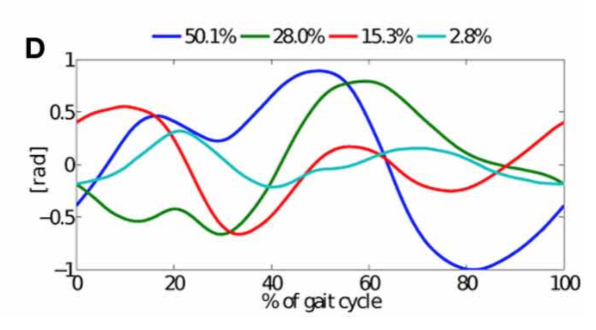Kinematic primitives for walking and trotting gaits of a quadruped robot with compliant legs

In this work we research the role of body dynamics in the complexity of kinematic patterns in a quadruped robot with compliant legs. Two gait patterns, lateral sequence walk and trot, along with leg length control patterns of different complexity were implemented in a modular, feed-forward locomotion controller. The controller was tested on a small, quadruped robot with compliant, segmented leg design, and led to self-stable and self-stabilizing robot locomotion. In-air stepping and on-ground locomotion leg kinematics were recorded, and the number and shapes of motion primitives accounting for 95\% of the variance of kinematic leg data were extracted. This revealed that kinematic patterns resulting from feed-forward control had a lower complexity (in-air stepping, 2–3 primitives) than kinematic patterns from on-ground locomotion (νm4 primitives), although both experiments applied identical motor patterns. The complexity of on-ground kinematic patterns had increased, through ground contact and mechanical entrainment. The complexity of observed kinematic on-ground data matches those reported from level-ground locomotion data of legged animals. Results indicate that a very low complexity of modular, rhythmic, feed-forward motor control is sufficient for level-ground locomotion in combination with passive compliant legged hardware.
| Author(s): | Spröwitz, Alexander Thomas and Ajallooeian, Mostafa and Tuleu, Alexandre and Ijspeert, Auke Jan |
| Journal: | Frontiers in Computational Neuroscience |
| Volume: | 8 |
| Number (issue): | 27 |
| Pages: | 1--13 |
| Year: | 2014 |
| Bibtex Type: | Article (article) |
| DOI: | 10.3389/fncom.2014.00027 |
| URL: | http://journal.frontiersin.org/Journal/10.3389/fncom.2014.00027/abstract |
| Electronic Archiving: | grant_archive |
BibTex
@article{sprowitz_kinematic_2014,
title = {Kinematic primitives for walking and trotting gaits of a quadruped robot with compliant legs},
journal = {Frontiers in Computational Neuroscience},
abstract = {In this work we research the role of body dynamics in the complexity of kinematic patterns in a quadruped robot with compliant legs. Two gait patterns, lateral sequence walk and trot, along with leg length control patterns of different complexity were implemented in a modular, feed-forward locomotion controller. The controller was tested on a small, quadruped robot with compliant, segmented leg design, and led to self-stable and self-stabilizing robot locomotion. In-air stepping and on-ground locomotion leg kinematics were recorded, and the number and shapes of motion primitives accounting for 95\% of the variance of kinematic leg data were extracted. This revealed that kinematic patterns resulting from feed-forward control had a lower complexity (in-air stepping, 2–3 primitives) than kinematic patterns from on-ground locomotion (νm4 primitives), although both experiments applied identical motor patterns. The complexity of on-ground kinematic patterns had increased, through ground contact and mechanical entrainment. The complexity of observed kinematic on-ground data matches those reported from level-ground locomotion data of legged animals. Results indicate that a very low complexity of modular, rhythmic, feed-forward motor control is sufficient for level-ground locomotion in combination with passive compliant legged hardware.},
volume = {8},
number = {27},
pages = {1--13},
year = {2014},
slug = {sprowitz_kinematic_2014},
author = {Spr{\"o}witz, Alexander Thomas and Ajallooeian, Mostafa and Tuleu, Alexandre and Ijspeert, Auke Jan},
url = {http://journal.frontiersin.org/Journal/10.3389/fncom.2014.00027/abstract}
}

